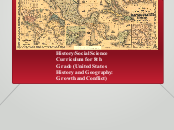by Mitchell Dail 8 years ago
428
History/Social Science Curriculum

by Mitchell Dail 8 years ago
428

More like this
8.9.4
8.5.1
8.1.1
Examine the location and effects of urbanization, renewed immigration, and industrialization (e.g., the effects on social fabric of cities, wealth and economic opportunity, the conservation movement)
8.12.5
Trace the boundaries constituting the North and the South, the geographical differences between the two regions, and the differences between agrarians and industrialists
8.10.2
Subtopic
Describe the country's physical landscapes, political divisions, and territorial expansion during the terms of the first four presidents
8.4.1
Economics
Explain how states and the federal government encouraged business expansion through tariffs, banking, land grants, and subsidies
8.12.3
Describe the development of the agrarian economy in the South, identify the locations of the cotton-producing states, and discuss the significance of cotton and the cotton gin
8.7.1
Enumerate the advantages of a common market among the states as foreseen in and protected by the Constitution’s clauses on interstate commerce, common coinage, and full-faith and credit
8.3.3
Describe the basic law-making process and how the Constitution provides numerous opportunities for citizens to participate in the political process and to monitor and influence government (e.g., function of elections, political parties, interest groups)
8.8.1
Analyze the significance of the States’ Rights Doctrine, the Missouri Compromise (1820), the Wilmot Proviso (1846), the Compromise of 1850, Henry Clay’s role in the Missouri Compromise and the Compromise of 1850, the Kansas-Nebraska Act (1854), the Dred Scott v. Sandford decision (1857), and the Lincoln-Douglas debates (1858)
8.9.5
Understand the Thirteenth, Fourteenth, and Fifteenth Amendments to the Constitution and analyze their connection to Reconstruction
8.11.5
H-SS AS: Students assess the credibility of primary and secondary sources and draw conclusions from them
8.7.2 Trace the origins and development of slavery; its effects on black Americans and on the region’s political, social, religious, economic, and cultural development; and identify the strategies that were tried to both overturn and preserve it (e.g., through the writings and historical documents on Nat Turner, Denmark Vesey)
H-SS AS: Students detect the different historical points of view on historical events and determine the context in which the historical statements were made (the questions asked, sources used, author’s perspectives)
8.10.5 Study the views and lives of leaders (e.g., Ulysses S. Grant, Jefferson Davis, Robert E. Lee) and soldiers on both sides of the war, including those of black soldiers and regiments
H-SS AS: Students frame questions that can be answered by historical study and research
8.12.6 Discuss child labor, working conditions, and laissez-faire policies toward big business and examine the labor movement, including its leaders (e.g., Samuel Gompers), its demand for collective bargaining, and its strikes and protests over labor conditions
CCSS.ELA.Literacy-RH.6-8.8 Distinguish among fact, opinion, and reasoned judgment in a text